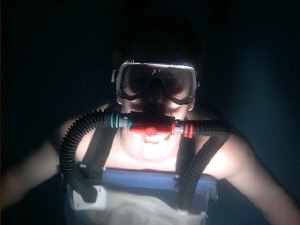
Award #7
(... and our usual latest news
update ...)
For answering the call...
"If You Can't Build A Rebreather,
You Shouldn't Dive A Rebreather."
It is with great pleasure that the CEDU Recognize and Present the "Honors of the Association" Award to the following individual for outstanding achievement in the Design, Construction and Use of HomeBuilt Closed Circuit Rebreathing Apparatuses. (And More...)

Without instruction, coaching, reverse engineering or plagiarism, the above named individual has designed, built, dived, and shared his enthusiasm and dive toys with friends, family, and the world at large.
This CEDU Honors of the Association is presented to Harrison Balthaser of Honesdale, PA.
Harrison Balthaser, our favorite Stourbridge Lion cub, took the plunge and joined the ranks of CEDU Honorees by successfully building and diving his R.O.X. (Rubbermaid Oxygen Rebreather).
As can be seen in the images below, excellence in engineering design, layout, and construction, has been accomplished.
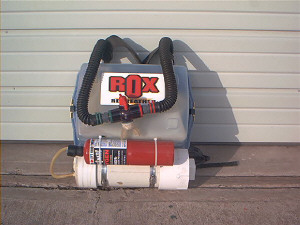

R.O.X. (Front and Back Views)
This front mounted oxygen rebreather includes: (1) a DSV (dive/surface valve) enhanced with color code to match the appropriate breathing hose ends, (2) an axial flow scrubber, (3) 31 liters of onboard oxygen, (4) a single counterlung, and (5) the most professionally made name Decal we have ever seen.

The counterlung is housed within the confines of a Rubbermaid Basin. The Rubbermaid Basin serves many functions; (1) it is the structural frame that the unit is built around, (2) it functions as the disinfecting tub for post dive clean-up and sanitation, and (3) it serves as the storage/transport container when it is not being dived. (It has also been known to house holiday ornaments during off season.)
Very clever engineering from Harrison. Our hat is off to You. We must say however that we always expect technological leadership and innovation from a son of Honesdale, PA. For those not familiar with railroad history, in August 8, 1829, from the great city of Honesdale, the Stourbridge Lion was the first steam locomotive to run on a commercial railroad in the United States. More info can be found at [link].
Harrison is also honored for other accomplishments.
The Rubbermaid Oxygen Rebreather (R.O.X.) is not the only item of dive gear to come from Harrison Balthaser. A home built Diver Propulsion Vehicle (DPV) pictured below puts him far ahead of the crowd. (He is one diver that will be hard to catch.)
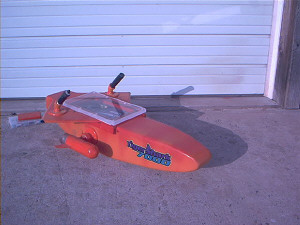
DPV "TigerShark 7000"
Other items made but not shown here include a video housing and canister dive lights.
Harrison's many creative and successful items of home built dive equipment are the accomplishments that are primarily honored here. A more important accomplishment which deserves recognition and praise is Harrison's public service to his community. Harrison Balthasar is not only a member of (since 1996), but currently the Captain of The Welcome Lake Dive Rescue Team.
For all the accomplishments mentioned above, and for his Community Service, the CEDU is indeed honored to recognize Harrison today.
Congratulations Harrison Balthasar, and remember to always dive in safety.
Respectfully Submitted,
Robert Iannello,
Director, CEDU
After action report
of the
CEDU Special Operations "A" Team
in
Underwater Navigation/Distance Rebreather Swim
Date:
DTG 20020210 1830Z
(Thats Sunday, 10 Feb. 2002, 10:30AM)
Location:
Malaga Cove/RAT Beach California
Coordinates:
From: 33 49.44 N 118 23.42 W
To: 33 48.47N 118 23.34W
Personnel:
Rogan, J, CEDU, The Admiral & Logistics Coordinator, Photographer
Iannello, R, Director Crestline Experimental Dive Unit, Swimmer
Simmel, E, CEDU Equipment Evaluator & Tactics Instructor, Swimmer
Equipment:
FEOR Light, FEOR
ExCap, Navigation Board
Weapons:
Dive Knife, Light Stick, Lobster Gauge/Bag, Fists
Objective:
One Mile Rebreather swim, arrive at the P.V. Estates Beach Club
within one hour of start
Obstacles / :
Patrol craft belonging to the L.A. Office of Homeland Security,
Dangers
aka L.A. Lifeguard Baywatch Boats
Surf Condition:
1-2 foot surf, 10-15 second surf interval
Water Visibility:
15-20 foot, reduced to 0-1 foot at very end of course
Water Temp.:
14.4C / 57.9F
Bottom Condition: Sand
bottom, occasional rocks
Flora:
Some Ribbon Kelp, and Giant Kelp
Fauna:
Bat Rays and other fauna indigenous to the So. Cal. Bite littoral
Maximum Depth:
5.2m / 17fsw
Average Depth:
3.8m / 12.5fsw (freebee from the computer)
Mile Swim Time:
46min
Total Dive Time:
53 min
Swim Rate:
56 kpm (kicks per minute) at the beginning, which slowed down to,
(kicks per minute)
44 kpm about 25 minutes into the swim.
O2 consumption:
1.08 slpm (total dive time)
[O2 use was determined for one diver only]
Nav. Accuracy: 40m / 130f of intended target location
Observations/Notes: (report follows)
It can now be said that the FEOR's have a few miles under their belts. It was on a beautiful Sunday morning, 10 February 2002, that a One Mile Underwater FEOR Compass Swim was planned and successfully conducted.
The exercise was planed to: (1) evaluate the FEOR's performance in a continuous swimming mode, (2) evaluate MY performance in a continuous Swimming and Navigating mode, as this would be the first time I would navigate and swim a mile nonstop while diving (No sightseeing and No underwater photography today) and of course, (3) to enjoy a day in the Pond.
With equipment (FEOR-light and FEOR ExCap) prepared, and pre-dive briefing conducted, the "A" Team assembled for final inspection.

Final Inspection. (Obligatory "Hero" Shot of Bob &
Erick)
(Just in case, this picture may have been useful for Search and
Rescue Personnel.)
The plan was simple, surface swim to our descent point. (Just beyond the surf zone.) Take last minute compass bearing, drop to the sea floor. After sorting out gear, connecting buddy line and checking depth and bearings we Started the clock and Started Swimming.
And Swim we did......
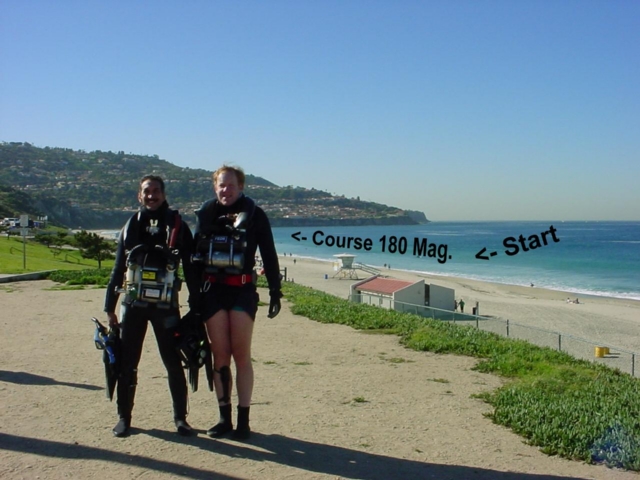
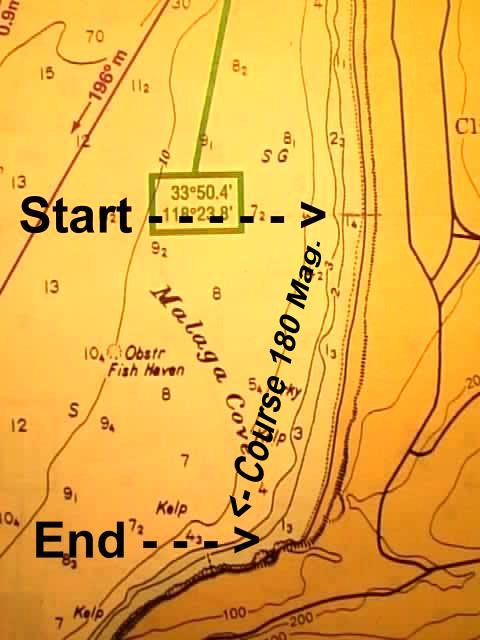
Technically it was a straight forward swim, almost uneventful if you will. A cardinal compass heading, a hard bottom, and we paralleled the coastline. Visibility was good in the 15-20 foot range most of the way. There were some areas where the visibility did reduce to 0-1 foot at the very end, where kelp and other debris tends to accumulate. Sea conditions were mostly 1-2 foot, with a very long wavelength between sets. Being in close to shore we were swimming in the influence of surge, which moved us about 5-10 feet from center. It was best to concentrate on the compass, and not the bottom moving back and forth(and back and forth and back and forth and back and ....).
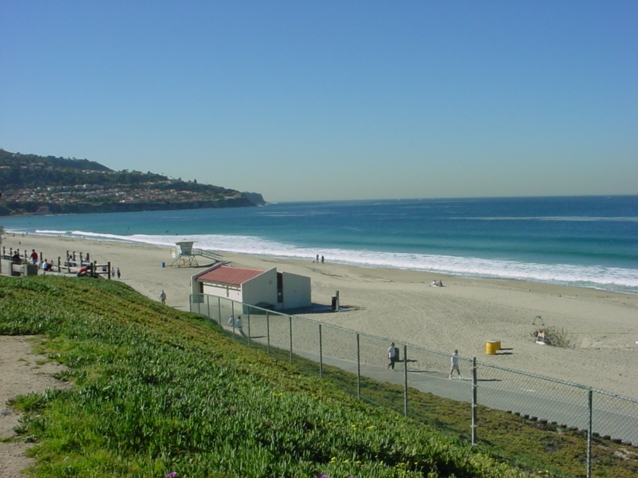
Can you find the FEOR Divers in this image?
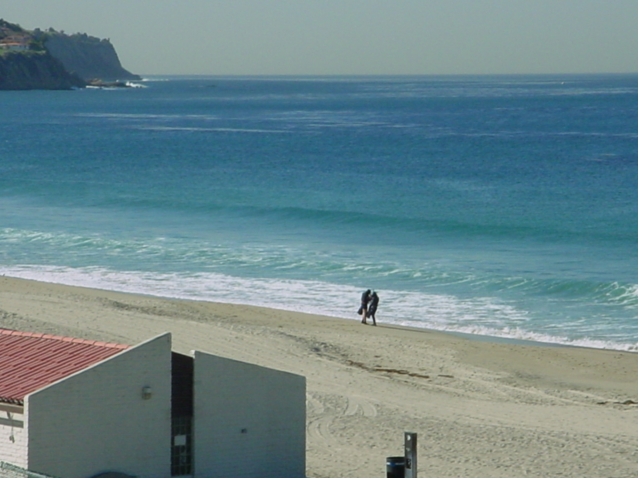
Sightseeing was not allowed, but we did see
about a dozen Bat Ray's swim by. We also noted some small rays and
other flat fish in the sand, kelp bass and a rock crab. Unfortunately
no lobster was seen. They must have sensed our license, gauge, and bag,
and therefore stayed hidden.
There was one moment of interest as Erick signaled me with a tug on the buddy line. He had me stop on the bottom for a moment and pointed to his ear. I though he was having an ear problem, but just then I noticed the shadow of a boat passing directly over head! With my 1/4 inch wetsuit hood, and in focused concentration of navigation and depth control, I did not hear the boat. Looking up, the boat seemed enormous to me, though it was only about 15-20 feet in length. It was a bit startling to have a boat pass that close overhead. We were only at a max. depth of 17 feet, which would put the boats propeller about ten feet away. It was an odd, brief encounter. My thought as the boat passed was the hope that he was not trolling. This is as close to a combat swimming situation as I care to come, although Erick may have other plans for me in the future (... he was mumbling something about Limpet mines, but we will leave that for another report. And yes, we have no hand grenades either.)
I didn't think that there would be boat traffic as close to the beach as we were. I will think about boat traffic a little more carefully in the future, and I will do my best to keep my ears on. The stop only lasted for a few seconds, and we were back on our swim.
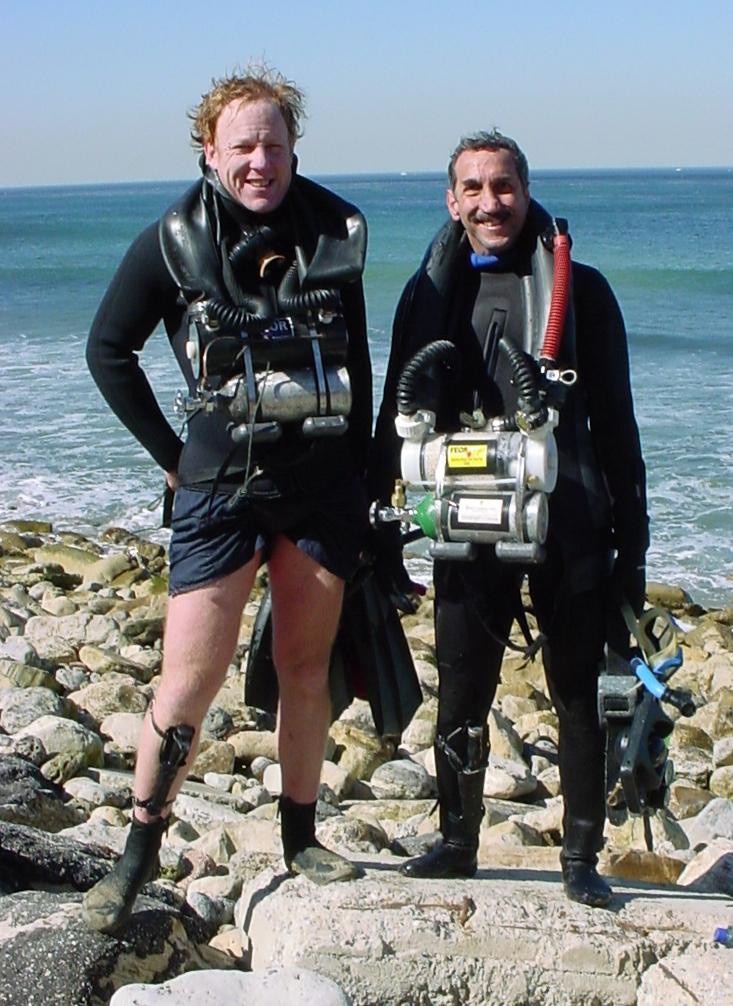
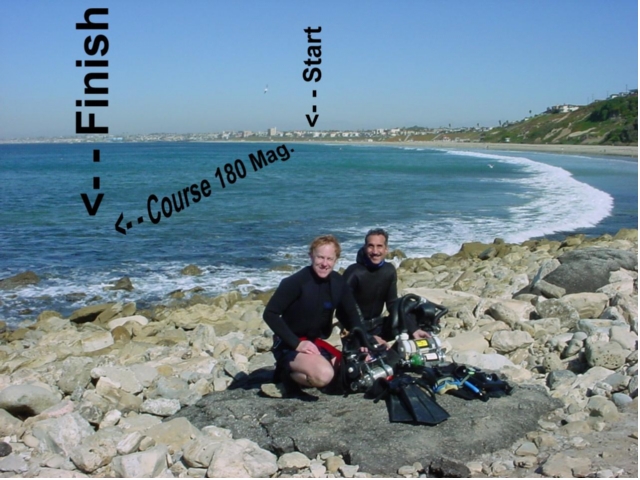
Heroes at the Finish.
Overall view of the course. (A great day for a swim.)
How did the units perform? Flawlessly. These are manual addition oxygen rebreathers, and you do have to crack open the tank valve to add oxygen to the system occasionally. There really was no inconvenience to operating the oxygen addition valve periodically even while maintaining compass heading and depth. It was not considered a stress factor.
What was a stress factor for me was the body position I maintained doing this exercise. Arms were stretched in front holding the navigation board and my head was looking forward. Normally my arms are to my side, and I am looking down. (At the pretty fishies...) My 1/4 inch wetsuit is cut such that the arms are to the sides and head is looking forward. In the above mentioned swimming position, muscle energy is expended to stretch the neoprene for arms forward, head forward navigation swimming. I also noted that my back was in a flexed position. By the end of the swim my lower back was getting a bit sore. It was good to take off the weightbelt and stand erect again.
The navigation came out better than I expected, as we arrived within about a hundred feet of the intended destination. (I thought that was great.) Erick was a perfect swim buddy. Though we were connected together with a "buddy" line, the only time I was aware that we were tied together was when he signaled me with a tug of the line. I am the slower swimmer, and Erick did a perfect job of matching my speed. Being just out of my peripheral vision, it was a little odd swimming with someone for so long and not seeing him. I had to turn around occasionally just to make sure he was there. My swim buddy kept a log of my fin kicks and other timing information, and provided operational security. (As mentioned above with that boat passing incident, it seems that the intensity of my navigating left me a bit vulnerable.)
In all it was a GREAT swim, and very motivating.
Finally a very big Thank You goes to my wife the Admiral Jane, for taking the pictures, providing all the logistics support, and of course for all her love.
Sincerely,
Robert Iannello,
Director, CEDU
P.S. The CEDU highly recommends that all of you rebreather divers (for the fun of it), swim an underwater mile to tune up both your equipment and yourself. Try it, you'll like it.
(Oh, and yes I must tell you that this is just
one more hoop to jump through in order to become a member of the CEDU.
The bar keeps raising....)
There's only one step down from here, baby,
It's called the land of permanent bliss.
What's a sweetheart like you doin' in a dump like this?
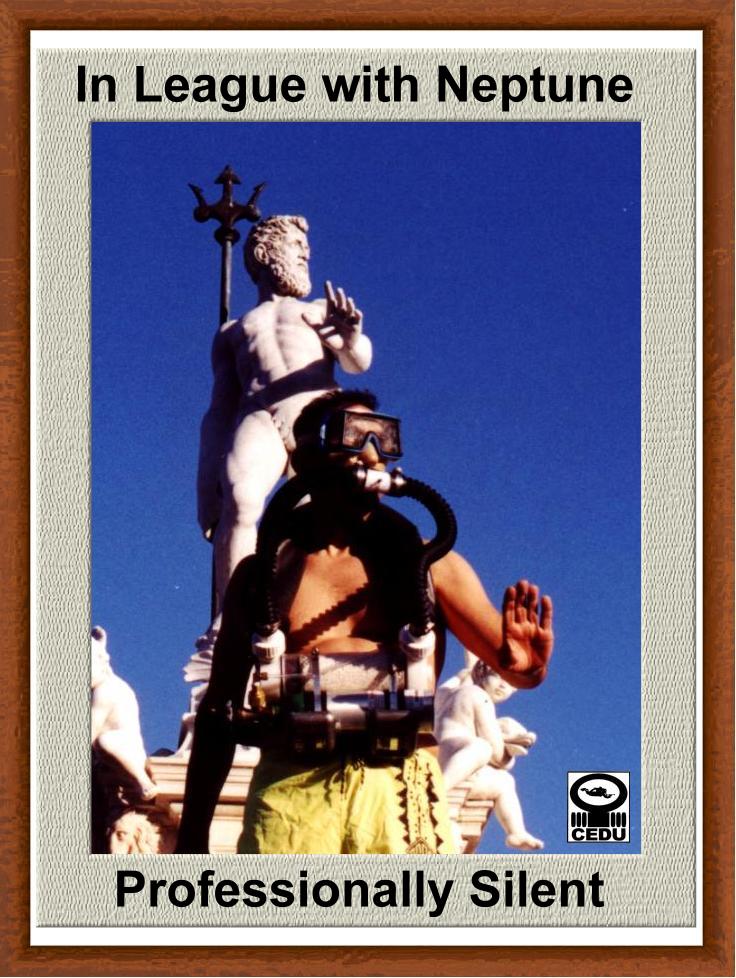
FEOR is there.
The only rebreather backed by Neptunus Rex himself.
Gentleman, Choose Your Equipment.

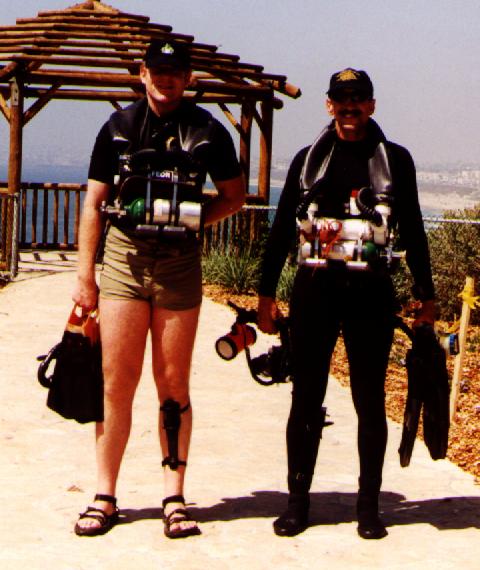
With so many choices in closed circuit gear, which do
you choose?
The FEOR
comes in many Styles and Configurations.
Become an UnAuthorized HomeBuilder
and make your own.
Then you can
Dive Into Oblivion with the
CEDU.
OSHA States:
"Compressed oxygen cannot be used in a device designed for compressed air
because minute amounts of oil or other foreign matter in the device components
can cause an explosion." In fact, 30 CFR 11 prohibits certification
of any device designed to permit interchangeable use of oxygen and air.
It is an accepted safety rule that: OXYGEN NEVER BE USED IN A DEVICE
UNLESS IT IS SPECIFICALLY DESIGNED FOR THAT PURPOSE.
Congratulations to the latest Honors Recipients.
A major step into CEDU membership has been accomplished.
Additional information about membership will start with
an Application.
Other requirements such as the MudRun
and the Rough Water Swim#1,
#2 follow....
Good Luck.
More information about Rebreathers/SUBLIME/and the
CEDU can be found starting at Dr.
Bob's The Home Page
"To Swim Is Human, To Dive Is SUBLIME"
And Remember CEDU's Mission
Statement:
"To Design, Assemble and Use Homemade Dive Gear While Maximally
Stroking Our Own Ego's and Maintaining the Merest Semblance of Sobriety
for the Benefit of Mankind"